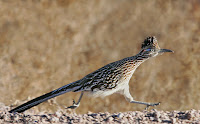Chuck Jones, in his 1999 memoir Chuck Amuck: The Life and Times of an Animated Cartoonist, laid out the nine rules that every episode of Looney Tunes' Road Runner/Wile E. Coyote cartoons had to abide by. They are not rules I would want to live by, but for cartoon characters? They made for some pretty funny situations.
Rule 1. The road runner cannot harm the coyote except by going "beep-beep!"
Rule 2. No outside force can harm the coyote—only his own ineptitude or the failure of the Acme products.
Rule 3. The coyote could stop anytime—if he were not a fanatic.
(Repeat: "A fanatic is one who redoubles his effort when he has
forgotten his aim." George Santayana)
Rule 4. No dialogue ever, except "beep-beep!"
Rule 5. The road runner must stay on the road—otherwise, logically, he would not be called road runner.
Rule 6. All action must be confined to the natural environment of the two characters—the Southwest American desert.
Rule 7. All materials, tools, weapons, or mechanical conveniences must be obtained from the Acme Corporation.
Rule 8. Whenever possible, make gravity the coyote's greatest enemy.
Rule 9. The coyote is always more humiliated than harmed by his failures.
I have to say, whenever I see a real roadrunner (sometimes they actually are on roads!), I am beyond delighted. They are iconic and beautiful, even, in a way, majestic. In California and the Southwest, we have Geococcyx californianus, the greater roadrunner (there's a lesser one in Mexico and Central America). They are "ground cuckoos" (the meaning of their generic name) in the subfamily Neomorphinae. (Something I did not know until now: the word coccyx, meaning tailbone, comes from the Greek word for, yes, cuckoo!, for its resemblance to the cuckoo's beak.)
Roadrunners are monogamous and mate for life. "During the courtship display," according to Wikipedia, "the male bows, alternately lifting and dropping his wings and spreading
his tail. He parades in front of the female with his head high and his
tail and wings drooped, and may bring an offering of food." The roadrunner's nest is usually composed of sticks, but may also contain leaves, feathers, snake skins, or dung. It is commonly placed up to nine feet off the ground, in a low tree, bush, or cactus. The eggs are generally white. Both sexes incubate the nest (with males taking the night shift) and feed the hatchlings. For the first couple of weeks
after the young hatch, one parent remains at the nest. The young leave
the nest at two to three weeks old, foraging with parents for a few days
after.
I expect a real roadrunner would just laugh at the above rules (or maybe coo or bark: you can listen to roadrunners here—they do not say "beep beep").
Though they'd probably also be happy to know that the coyote generally gets its comeuppance—at least in the dreamworld of Looney Tunes.
Subscribe to:
Post Comments (Atom)





1 comment:
Love this: "The word coccyx, meaning tailbone, comes from the Greek word for, yes, cuckoo!, for its resemblance to the cuckoo's beak."
Post a Comment